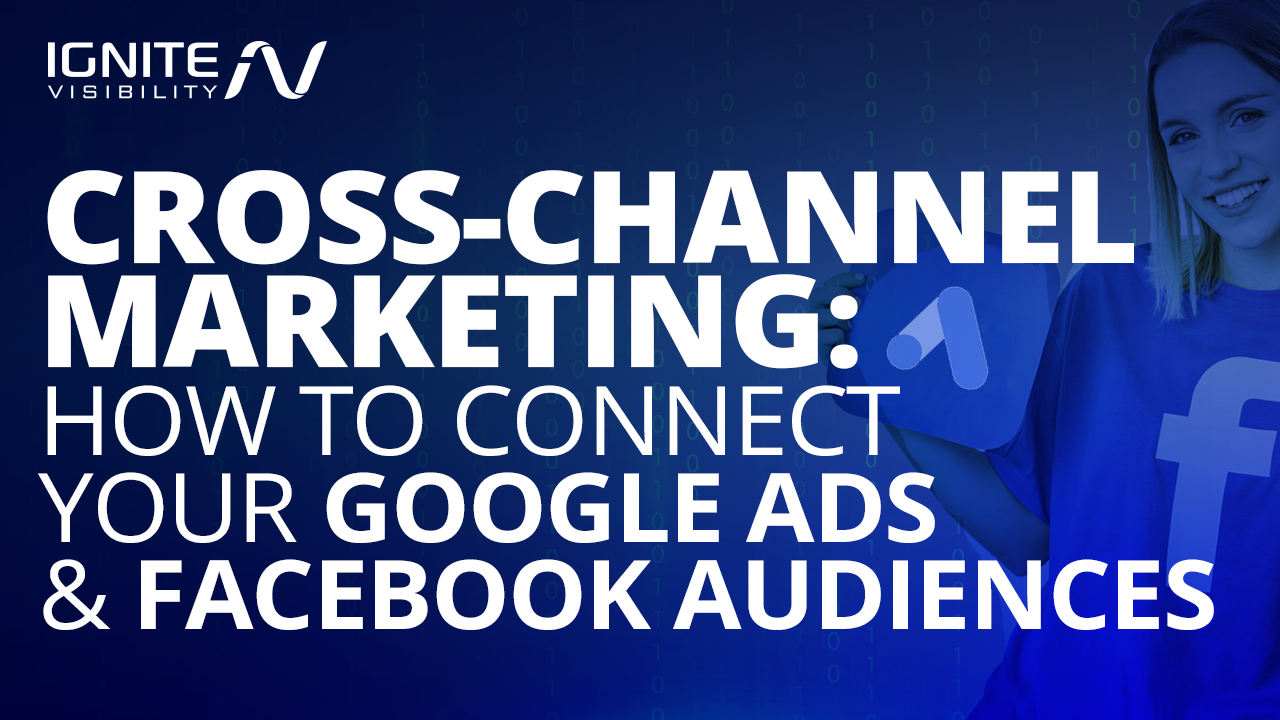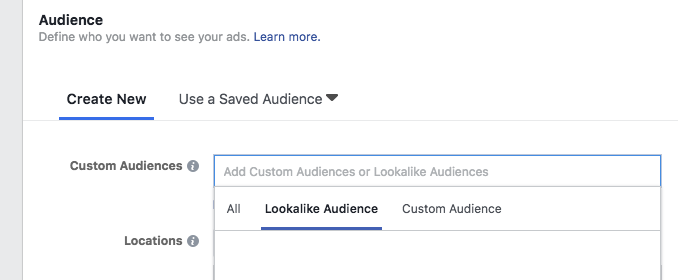I don’t have to tell you that marketing is a multi-channel affair, nor do I need to tell you that Google and Facebook are the key players.
Both tech giants are customer insight powerhouses, and while they may compete for their share of users’ attention, these two actually team up quite nicely when it comes to your marketing strategy.
In this article, I’ll give you a few tips on how to combine your Facebook and Google ads audiences for more effective campaigns.
What We’ll Cover:
- The benefits of cross-channel marketing on Google and Facebook
- How cross-channel marketing can reinforce your goals
- How to leverage search query data
- How to use Facebook ads to retarget search audiences
- How to create a Lookalike Audience that aligns with search queries
- How to use Facebook Audiences in Google Ads
- How to combine data from Google Shopping ads and Facebook ads
The Benefits of Cross-Channel Marketing on Google and Facebook
Search and social are natural complements—mainly because you’re combining two high volume sources of data.
Roughly 35% of shopping-related queries begin on Google, as do 90% of desktop searches and 60% of searches performed on mobile.
According to Pew Research, 68% of Americans use Facebook and 74% of users visit the platform daily. The platform also boasts 8 billion video views a day.
Of course, there are countless statistics that prove just how much data the two platforms have at their disposal. The point is, those advertisers who layer data from both platforms stand to see several benefits including more views, clicks, and conversions.
But combining the two is a far more effective way to push awareness and sales.
In fact, customers who click both social and search ads are 2x more likely to convert than users who click just one.
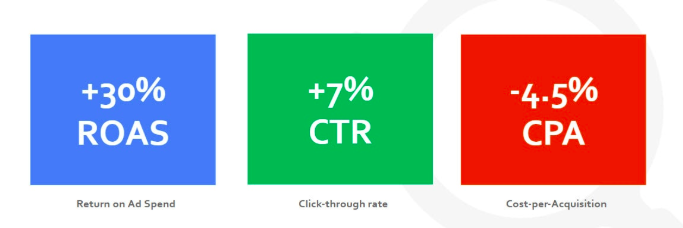
Cross-channel marketing: using Facebook and Google together results in much higher returns
Oh, and did I mention customers who click both search and social ads tend to spend more?
They do.
So, I highly suggest you take the cross-channel advertising approach.
Note: To use a lot of the tactics below, you’ll need to familiarize yourself with the Facebook Pixel and UTM tagging.
The Facebook Pixel is a piece of code you place on your website to help track conversions from Facebook ads.
UTM tagging is a way to inform Google Analytics of the path a visitor took to get to your site. For more on that, read my full article here.
You’ll also want to make sure that you connect your Google Analytics account to your Google Ads account. Google will go over the set-up steps here, but the benefit of linking the two accounts is, Analytics comes with access to more data about user behavior, preferences, demographics, and so on.
Now let’s dig into some tips and strategies.
Cross-Channel Marketing: Reinforce Your Goals on Facebook and Google
To make the most of your cross-channel marketing, everything you put out should work to support the same goal.
That means that the ad formats you select on both platforms should mirror each other in objective.
Take a look at the image below.
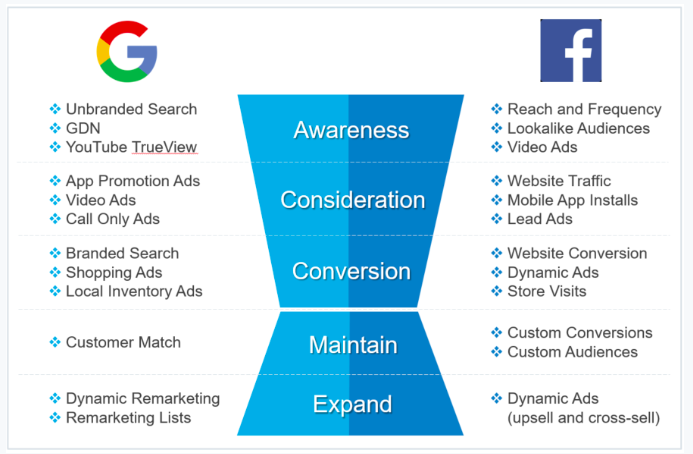
Cross-Channel Marketing from Marin’s Software ‘Facebook + Google: Bridging the Search and Social Divide’.
The graphic breaks down each stage in the sales funnel and maps out which ad formats work best for each stage.
So, if I were an e-commerce store running ad campaigns to increase conversions, I might combine Google Shopping Ads with Facebook Store Visits.
Cross-Channel Marketing: Leverage Search Query Data
This is one of the greater benefits of cross-channel marketing.
See, users are typing exactly what they’re looking for into Google, and as marketers, you can use that information to better target and optimize your ads – on both search and social.
Search information can be used to create ad copy based on what real users are searching for. For example, if you notice that users are clicking on your search ads after searching for specific queries, you can then use those search queries to inform your next round of social ads.
For example, if you sell furniture and a large number of your audience is searching for “modern decor,” you can feature that phrasing and imaging in your Facebook ads.
But that’s just the beginning—search query data can be used to identify new content ideas or bring new prospects into the sales funnel.
How to Use Facebook Ads to Retarget Search Audiences
I’ll spare you all the details regarding why cross-channel remarketing is essential for all brands. If you’re curious, you can read my full remarketing spiel here.
After all, if you’re running campaigns on Google and Facebook you’re likely already familiar. But there’s a lot more to remarketing than following users around the internet with the same ad for the same product.
And one of the best ways to use it? Cross-channel advertising.
It works like this: if someone found your website through a search ad, you can use the term they used to find your site to target them on Facebook.
Here’s an example from Wordstream of a Facebook ad that displayed to people who searched for “ebay templates” on Google.
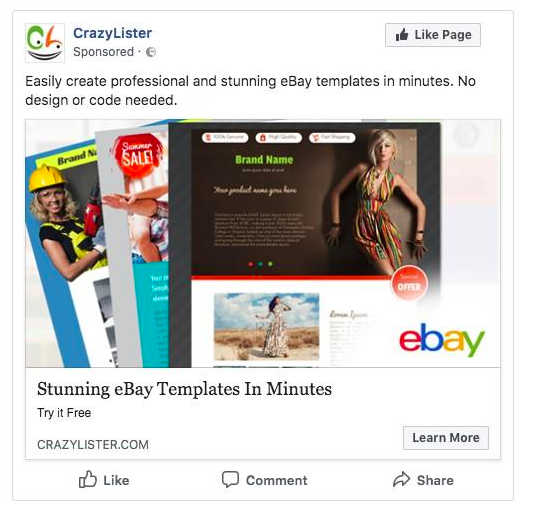
Cross-channel Advertising: Facebook + Google
Pretty cool, right?
And it’s not even all that complicated to set up.
First, ensure your Google ads are sending users to unique landing pages.
These landing pages should be set up with one of those UTM tracking codes we touched on earlier (read more about UTM tracking + Facebook here).
Then, you’ll navigate to your Facebook Ads Manager and over the Audience tab.
There, you’ll create Custom Audience of people who have visited the specific landing page tied to your AdWords ad.
Here’s what Wordstream’s set up looked like when creating the ad above:
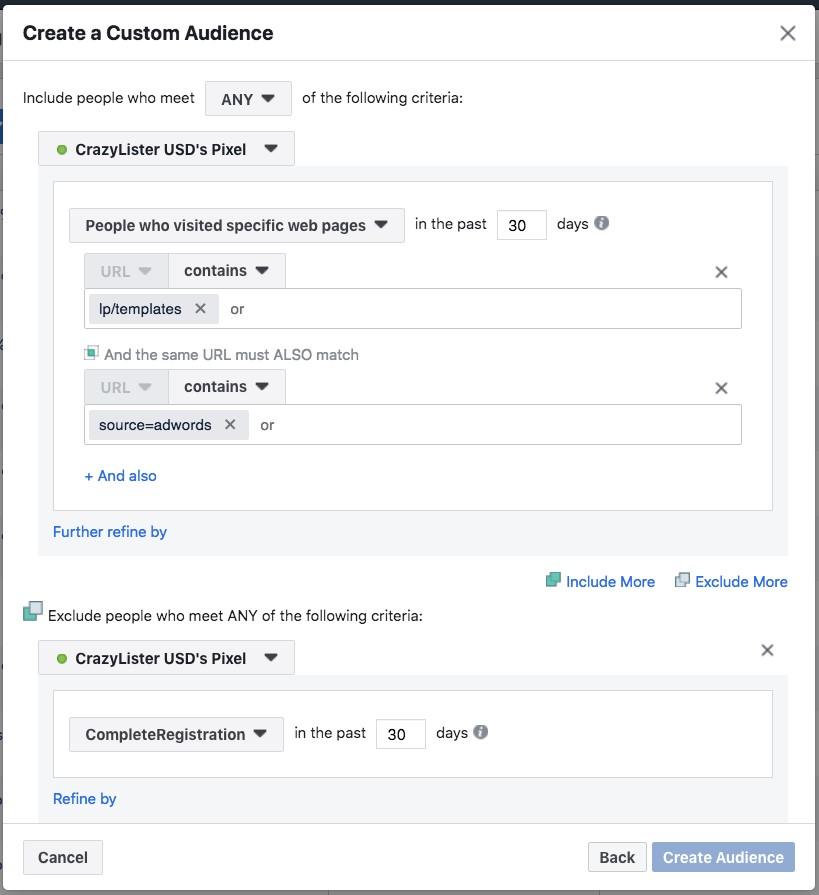
Cross-channel marketing: use search queries to build Facebook ads
Or, you might instead use Facebook audiences with Google Analytics to improve RSLA performance—a quick reminder, RSLAs are a variation on remarketing ads that target people searching for specific keywords.
Though you’re working with a smaller sample size, this method is an affordable way to improve your conversion rate.
Search Engine Journal found that adding Facebook audiences to RSLA campaigns produced the following results:
Cross-Channel Marketing: Create a Lookalike Audience That Aligns with Search Queries
You can also take that custom audience a step further (and reach a lot more people) by creating a Facebook Lookalike audience.
Again, I won’t go into too much detail about the power of lookalikes, but I’m a big fan of these and highly suggest you work them into your strategy.
In a nutshell, Lookalike Audiences are based on custom audiences and are used to target users similar to those in your existing custom audience.
So, if I have a custom audience built to target a certain search query, I can then build a lookalike audience based on what my site visitors were searching for.
This opens up a world of opportunity for cross-channel advertising.
Say, for example, my search query custom audience only had 1,000 users on it. By building a lookalike audience, I have the ability to target 10,000+ users who are similar to those searching for what I have to offer.
The set up will be similar, only this time you’ll select Lookalike audience in the Audience section. Then, choose the Custom Audience you’re basing it off of from the dropdown.
Cross Channel Advertising: Combine Facebook and Google Ads Audiences
One of AdWords biggest advantages is that users performing a search on Google generally have high buying intent.
The downside? Google doesn’t come with the same level of interests and demographic data you’ll find inside Facebook.
The sheer volume of users and the personal information they provide opens up a wealth of opportunities for cross-channel advertising strategies to drive major ROI. From relationship status, likes and dislikes, to educational backgrounds, income brackets, and a whole host of habits, Facebook brings extremely powerful and specific targeting abilities to advertisers.
Even better, those powerful insights don’t necessarily have to stay in Facebook. Using Facebook audiences in AdWords campaigns means that your search campaigns now have more context, and as a result, are more effective than your average PPC ad.
Here’s how to connect Google and Facebook:
First, you’ll need to create an Audience in Facebook with all the relevant targeting options. Pay special attention to the Detailed Targeting to choose specifics regarding work, interests, and behavior.
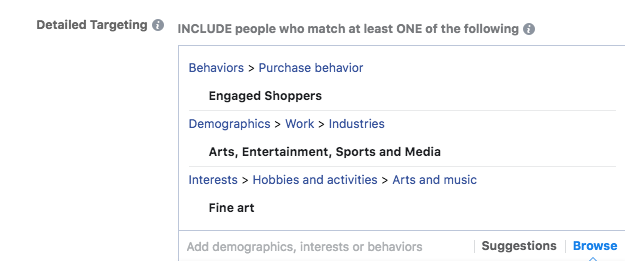
Cross-channel marketing: use detailed targeting in Facebook to better target on Google
But before you start running your ads, remember how we talked about UTM tracking?
This is where it starts to come into play. You’ll need to attach it to your campaign by setting one up in Google and listing Facebook as the source.
The URL generated is the one you’ll use with your Facebook campaign.
Then, the users that click through to that landing page from your Facebook ad can be used in a remarketing list in AdWords.
For full set-up instructions, click here.
Google Shopping Ads + Facebook Ads Mean Better E-commerce Cross-Channel Advertising Campaigns
We talked briefly about searcher intent. Mainly, shoppers on Google have high buying intent.
Despite the fact that Google Ads are expanding to include Discovery Ads and other more passive methods of connecting with their audience, traditional search still comes with that unique advantage when it comes to intent. And for e-commerce businesses, there’s no better way to bring in serious online dollars than with Google Shopping Ads.
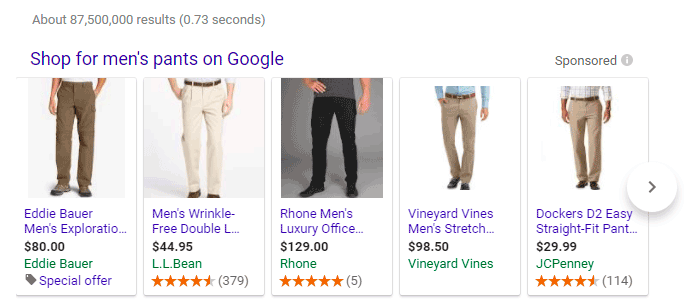
Cross-channel marketing: Google shopping ads can be used for remarketing on Facebook
But on Facebook, not so much.
And it makes sense; after all, no one really fires up Facebook to go shopping.
They aren’t there to browse or buy your products, and purchase intent on the platform is pretty low, all things considered.
But that doesn’t mean it can’t help your e-commerce campaigns.
How?
By showing ads to people who have searched for or clicked on you Shopping ads.
Think about it this way: though people on the search network generally have purchase intent, it doesn’t mean they’re ready to purchase right now.
That’s especially true if you’re advertising big-ticket items like jewelry, name brand clothing, automobiles, etc.
Usually, people do some shopping around before sealing the deal.
But while they do that shopping, you need a way to keep them interested in your brand.
That’s where Facebook comes into play.
If someone shows interest in your Shopping ad but doesn’t purchase, you can try a different outlet and reach them, instead, on Facebook.
(Note: you can also use this remarketing strategy using the Google Display Network instead of Facebook).
You can set this up using the same UTM tracking process as before. Just include in the shopping ad’s landing page URL, and target URL visits on Facebook with the same UTM link.
Bottom Line: Cross-Channel Marketing Campaigns Take Paid Ads to the Next Level
There are many good reasons why cross-channel marketing should be a key ingredient in your overall marketing strategy, especially where stacking Facebook Insights and Google Audiences are concerned.
Together, they drive the most marketing dollars and see the highest results from users.
You can use the intel gathered on either channel to enhance the other, whether it’s through search queries, Lookalike Audiences, complementary objectives or driving purchase intent.
Just remember: Facebook + Google = results.
